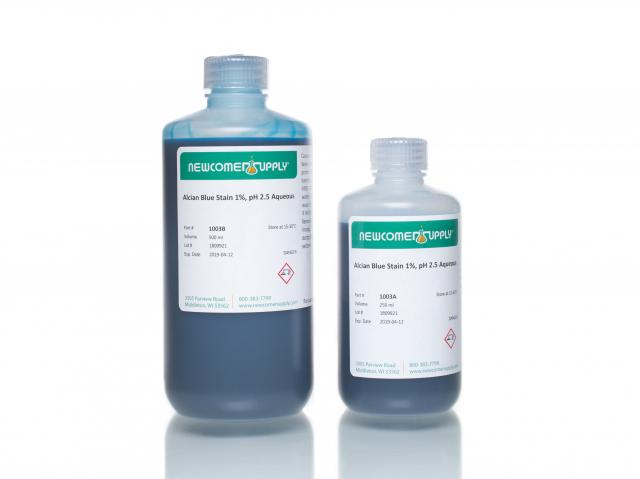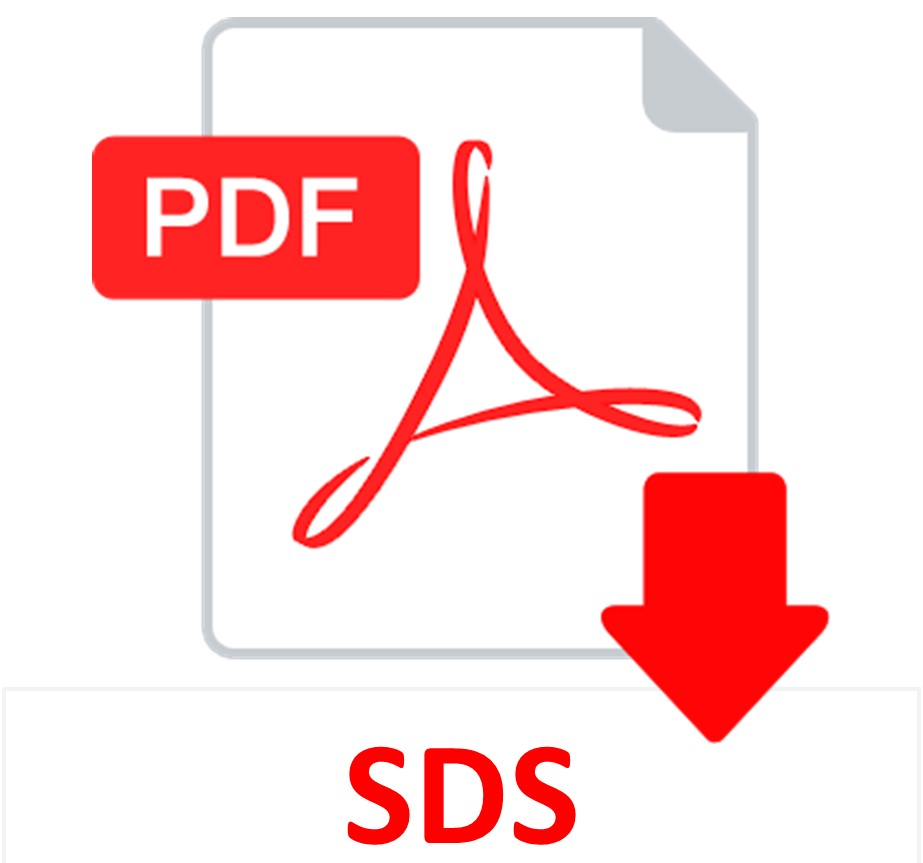Alcian Blue Stain 1%, pH 2.5 Aqueous
(use: Acidic Mucins & Carboxylated Mucosubstances; including Barrett’s Esophageal Biopsy.)
Tech Memo 1: Alcian Blue Stain 1%, pH 2.5
SOLUTION:
| 250 ml | 500 ml | |
| Alcian Blue Stain 1%, pH 2.5 Aqueous | Part 1003A | Part 1003B |
Additionally Needed:
| Alcian Blue pH 2.5, Umbilical Cord Control Slides OR Alcian Blue pH 2.5, Multi-Tissue Control Slides |
Part 4020 OR Part 4021 |
| Acetic Acid 3%, Aqueous | Part 10017 |
| Nuclear Fast Red Stain, Kernechtrot | Part 1255 |
| Xylene, ACS | Part 1445 |
| Alcohol, Ethyl Denatured, 100% | Part 10841 |
| Alcohol, Ethyl Denatured, 95% | Part 10842 |
For storage requirements and expiration date refer to individual bottle labels.
APPLICATION:
Newcomer Supply Alcian Blue Stain 1%, pH 2.5 Aqueous is designed to stain acid epithelial mucins (sialomucin, sulfomucin) as well as stromal (mesenchymal) mucin in the Alcian Blue Stain 1%, pH 2.5 procedure.
METHOD:
Fixation: Formalin 10%, Phosphate Buffered (Part 1090)
Technique: Paraffin sections at 4 microns
Solutions: All solutions are manufactured by Newcomer Supply, Inc.
All Newcomer Supply stain procedures are designed to be used with Coplin jars filled to 40 ml following the provided staining procedure.
STAINING PROCEDURE:
- If necessary, heat dry tissue sections/slides in oven.
- Deparaffinize sections thoroughly in three changes of xylene, 3 minutes each. Hydrate through two changes each of 100% and 95% ethyl alcohols, 10 dips each. Wash well with distilled water.
- See Procedure Notes #1 and #2.
- Place slides in Acetic Acid 3%, Aqueous (Part 10017) for 3 minutes.
- Move slides directly into Alcian Blue Stain 1%, pH 2.5 Aqueous. Stain for 30 minutes at room temperature or for 15 minutes in a 37°C water bath.
- Wash in running tap water for 10 minutes; rinse in distilled water.
- See Procedure Note #3.
- Counterstain in Nuclear Fast Red Stain, Kernechtrot (Part 1255) for 5 minutes.
- Shake solution well before use; do not filter.
- Rinse well in distilled water.
- See Procedure Note #4
- Dehydrate quickly through two changes of 95% ethyl alcohol and two changes of 100% ethyl alcohol. Clear in three xylene changes, 10 dips each; coverslip with compatible mounting medium.
RESULTS:
| Acid epithelial mucin | Blue |
| Stromal (mesenchymal) mucin | Blue |
| Nuclei | Pink-red |
| Cytoplasm | Pale pink |
PROCEDURE NOTES:
- Drain slides after each step to prevent solution carry over.
- Do not allow sections to dry out at any point during procedure.
- A brief dip in Acetic Acid 3%, Aqueous from Step #3 can be added before rinsing to remove excess Alcian Blue Stain 1%, pH 2.5 Aqueous if needed.
- Wash well after Nuclear Fast Red Stain, Kernechtrot to avoid cloudiness in dehydration steps.
- If using a xylene substitute, closely follow the manufacturer’s recommendations for deparaffinization and clearing steps.
REFERENCES:
- Carson, Freida. Histotechnology: A Self-Instructional Text. 2nd ed. Chicago: ASCP Press, 1997. 118-120.
- Sheehan, Dezna C., and Barbara B. Hrapchak. Theory and Practice of Histotechnology. 2nd ed. St. Louis: Mosby, 1980. 172-173.
- Modifications developed by Newcomer Supply Laboratory.
Tech Memo 2: Alcian Blue/PAS Stain
SOLUTION:
| 250 ml | 500 ml | |
| Alcian Blue Stain 1%, pH 2.5 Aqueous | Part 1003A | Part 1003B |
Additionally Needed:
| Alcian Blue/PAS Control Slides | Part 4022 |
| Acetic Acid 3%, Aqueous | Part 10017 |
| Periodic Acid 0.5%, Aqueous | Part 13308 |
| Schiff Reagent, McManus | Part 1371 |
| Hematoxylin Stain, Mayer Modified | Part 1202 |
| Xylene, ACS | Part 1445 |
| Alcohol, Ethyl Denatured, 100% | Part 10841 |
| Alcohol, Ethyl Denatured, 95% | Part 10842 |
For storage requirements and expiration date refer to individual bottle labels.
APPLICATION:
Newcomer Supply Alcian Blue Stain 1%, pH 2.5 Aqueous, a crucial element in the Alcian Blue/PAS Stain procedure is used to differentiate between acidic epithelial mucins (sialomucin, sulfomucin) and neutral epithelial mucin and is a means of detecting the overall presence of mucins. Acidic mucins are stained with the Alcian Blue technique while neutral mucins and glycogen are stained by the PAS reaction.
METHOD:
Fixation: Formalin 10%, Phosphate Buffered (Part 1090)
Technique: Paraffin sections cut at 4 microns
Solutions: All solutions are manufactured by Newcomer Supply, Inc.
All Newcomer Supply stain procedures are designed to be used with Coplin jars filled to 40 ml following the provided staining procedure.
STAINING PROCEDURE:
- If necessary, heat dry tissue sections/slides in oven.
- Deparaffinize sections thoroughly in three changes of xylene, 3 minutes each. Hydrate through two changes each of 100% and 95% ethyl alcohols, 10 dips each. Wash well with distilled water.
- See Procedure Notes #1 and #2.
- Place slides in Acetic Acid 3%, Aqueous (Part 10017) for 3 minutes.
- Place slides directly into Alcian Blue Stain 1%, pH 2.5 Aqueous for 15 minutes.
- Wash slides in gently running tap water for 1-2 minutes; rinse in distilled water.
- Place in Periodic Acid 0.5%, Aqueous (Part 13308) for 5 minutes.
- Wash in running tap water for 1-2 minutes; rinse in distilled water.
- Place slides in Schiff Reagent, McManus (Part 1371) for 10 minutes.
- Wash in lukewarm tap water for 5-10 minutes.
- Stain lightly in Hematoxylin Stain, Mayer Modified (Part 1202) for 1 minute.
- Rinse in running tap water for 1-2 minutes.
- Dehydrate in two changes each of 95% and 100% ethyl alcohol. Clear in three changes of xylene, 10 dips each; coverslip with compatible mounting medium.
RESULTS:
| Acid epithelial mucin | Violet |
| Neutral epithelial mucin | Magenta |
| Glycogen | Magenta |
| Stromal (mesenchymal) mucin | Blue |
PROCEDURE NOTES:
- Drain slides after each step to prevent solution carry over.
- Do not allow sections to dry out at any point during procedure.
- If using a xylene substitute, closely follow the manufacturer’s recommendations for deparaffinization and clearing steps.
REFERENCES:
- Bancroft, John D., and Marilyn Gamble. Theory and Practice of Histological Techniques. 6th ed. Oxford: Churchill Livingstone Elsevier, 2008. 173-174.
- Carson, Freida L., and Christa Hladik Cappellano. Histotechnology: A Self-instructional Text. 4th ed. Chicago: ASCP Press, 2015. 150-151
- Modifications developed by Newcomer Supply Laboratory.





